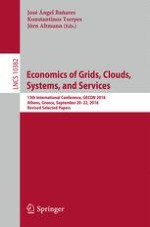This book constitutes the refereed proceedings of the 13th International Conference on Economics of Grids, Clouds, Systems, and Services, GECON 2016, held in Athens. Greece, in September 2016.
The 11 revised full papers and 11 short papers presented were carefully reviewed and selected from 38 submissions.
This volume has been structured following the seven sessions that comprised the conference program (three of which are work-in-progress sessions):
Session 1: Business Models
Session 2: Work in Progress on Quality of Services and Service Level Agreements
Session 3: Work in Progress on Cloud Economics
Session 4: Energy Consumption
Session 5: Resource Allocation
Session 6: Work in Progress on Resource Allocation
Session 7: Cloud Applications
